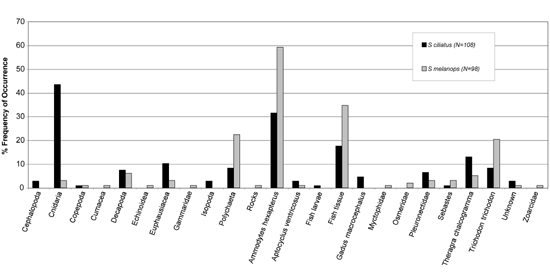Groundfish Assessment Program
Feeding Habits of Two Congener Species, Dark And Black Rockfish, in the Western Gulf of Alaska
Dark rockfish (Sebastes ciliatus) are often caught by commercial jig operations targeting black
rockfish (S. melanops) in the Gulf of Alaska. Rockfish feeding ecology research in Southeast Alaska
in summer 1980-82 found differences in the diets of black rockfish and both color morphs of dusky rockfish.
(These studies preceded the redescription of light and dark dusky rockfish color morphs into two distinct
species, dark and dusky (S. variabilis) rockfish.) Black rockfish were found to be primarily
piscivorous predators, feeding on Pacific sand lance (Ammodytes hexapterus), while dusky rockfish
primarily fed on invertebrate zooplankton such as brachyuran crab larvae.
In July 2001, 434 dark rockfish were caught as bycatch on an ADF&G black rockfish hook-and-line survey
conducted in the area around Sanak Island and Sandman Reef in the western Gulf of Alaska. Individual fish
were weighed, sexed, and measured, and the otoliths were removed to examine their age, growth, and natural
mortality. Stomach samples were also collected from both dark and black rockfish when the two species were
caught at the same stations to look for differences in diet and investigate niche overlap. The following
results of this study were presented in November at the 2004 annual meeting of the Alaska Chapter of the
American Fisheries Society in Sitka.
| |

Figure 5. Frequency of occurrence of prey items found in dark and black rockfish caught
near Sanak Island and Sandman Reef in the western Gulf of Alaska
(Click image to enlarge). |
Stomachs from 207 fish were analyzed, 98 collected from black rockfish and 109 from dark rockfish.
Both species had an abundance of Pacific sand lance and Pacific sandfish (Trichodon trichodon) in
their stomachs, although the frequency of occurrence of these fish prey species was greater in black rockfish
stomachs (59.2% and 20.4%, respectively) than in dark rockfish stomachs (31.5% and 8.3%).
Juvenile walleye pollock occurred more frequently in the diet of dark rockfish (13.0%) than black rockfish (5.1%), while
Pacific cod occurred only in dark rockfish, illustrating a wider variety of forage fish prey in the dark
rockfish diet. Polychaete worms were the most frequently observed invertebrates in the diet of black
rockfish, while cnidarians and euphasiids were the most frequent invertebrate prey for dark rockfish.
Crab larvae were also present in the stomachs of both predators and, while not a major contributor to the
black rockfish diet, were the fifth most important prey species of dark rockfish based on frequency
of occurrence (Fig. 5).
The proportion of black rockfish feeding exclusively on forage fish was higher than that of dark
rockfish (66% vs. 35%), while more dark than black rockfish fed exclusively on invertebrates (41% vs. 4%).
Dark rockfish stomachs more frequently contained both fish and invertebrate prey items, supporting the
previous conclusion that black rockfish are primarily piscivorous predators.
Niche overlap between the two species was examined. Niche breadth was calculated for each species using
Levin’s calculation, where a value of zero defines all prey items as from a single prey category, while a
value of 1 represents prey items are equally distributed from all prey categories. Black rockfish, with a
value of 0.09, demonstrated a very narrow niche, while dark rockfish’s niche was broader (value = 0.22).
Schoener’s Index of diet overlap between the two species was calculated to be 0.62. Values for this index
range from zero, no overlap in diet, to a maximum value of 1, indicating equal proportions of all prey items.
These results indicate that black and dark rockfish compete for similar prey resources, although black
rockfish exhibit a more specialized diet.
By Liz Chilton
>>>continued

|

|
Quarterly sidebar
AFSC Quarterly Research Reports Oct-Dec 2004
Contents
Feature
Items
ABL Reports
NMML Reports
RACE Reports
REFM Reports
Quarterly Index
Quarterly Home
|

